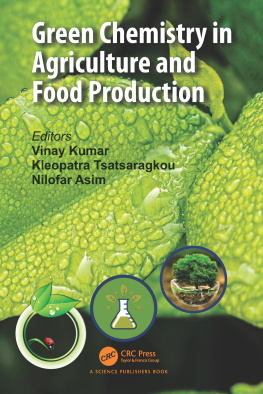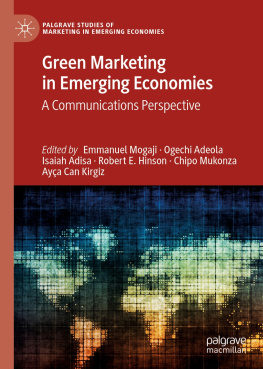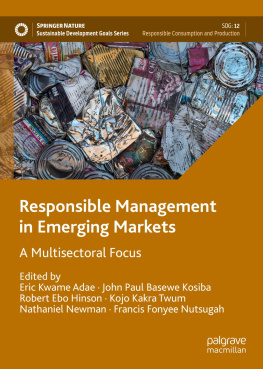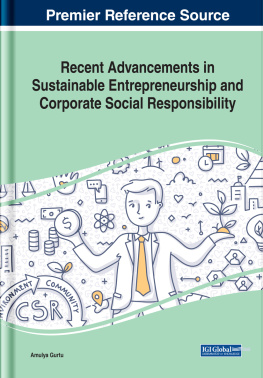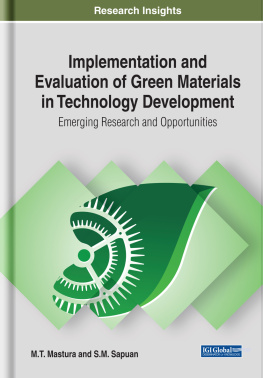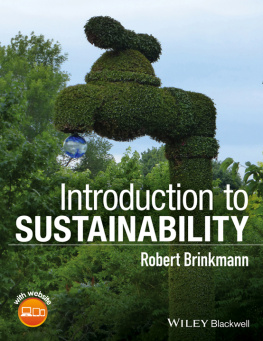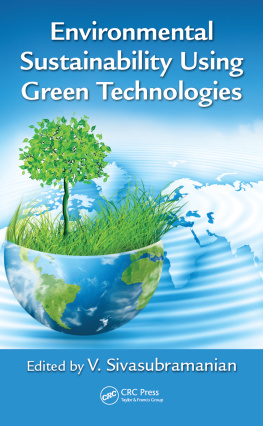Chapter 1
Antecedents of Green Consumerism
- Aylin Caliskan
Yasar University, Turkey
ABSTRACT
While green consumerism is considered as a solution to ecological problems, it is also seen as a good source of income and competitive advantage for commercial enterprises. It is extremely difficult for producers and marketers to design and position their green marketing efforts. Because green consumerism is not only a tendency towards products, but also a multi-faceted approach that varies from political struggle to ethical orientation. Therefore, green consumerism as a form of consumption is influenced by severe factors. Each green consumer exhibits different motivational drivers regarding to the attributes of a green product, service, or act. Therefore, it is vital to understand different preferences and different motivations among green customers. This chapter reviews the antecedents that affect the green purchasing behaviors of consumers. Factors affecting green consumerism are examined under three main headings: endogenous antecedents such as emotion, exogenous antecedents such as social norms, and structural antecedents such as price of the product.
INTRODUCTION
The concept of green can be seen in all echelons of a supply chain such as manufacturing, procurement, distribution, packaging, and warehousing. Green marketing acts as a facilitator which informs consumers, the last node of supply chains, about green products (Peattie & Charter, 2003). Green consumerism has evolved herein, where the downstream flow of information through the marketing channels happens (Srivastava, 2007).
Green consumerism is generally associated with consuming green products that have a positive or less negative influence on the environment, avoiding excessive consumption, preferring recyclable and energy efficient products, and reducing consumption of natural resources. Green consumption, rather than production is now an important concern for societal change and sustainability. Because sustainability is coming to the fore as a source of added value and competitive advantage for marketers and companies and a critical concern for policy makers it is vital for them to have a coherent understanding of precursors of green consumerism for promoting it.
The basis of the existence of businesses is based on meeting the needs and demands of consumers. The most important reason why firms differ from their competitors is that they can meet their customers' needs better than their competitors. Businesses will be able to develop products and services in accordance with the wishes of their customers as they can understand the needs of consumers. Green marketing elicited enormous favorable opportunities for differentiation, cost reduction, segmentation, and product and market development. However as Peattie & Charter (2003) indicated, because each green consumer exhibit different motivational drivers regarding to the attributes of a green product, it is extremely hard for producers and marketers to design and position their green product. Therefore, it is vital to understand different preferences and different motivations among green customers.
This chapters main aim is to focus on the key antecedents of green consumerism. These are vital and needed to be better understood in order to encourage green consumerism. This study summarizes each antecedent by supporting them with real cases and empirical studies.
BACKGROUND
By the effect of globalization and radical variations in the markets, consumption patterns of individuals have changed in time and accordingly new consuming behaviors have emerged since the rise of environmentalism (Cohen, 2001). The global temperatures rise and scarcity in natural resources increases. In the light of mentioned these changes, consumption patterns of individuals have shifted from mass to green in recent years. Green consumerism has an extremely important role in promoting environmental awareness. As being a comparatively new consuming behavior; green consumption has become one of the most remarkable trend that spreading very fast, links the eco - friendly consumption and more environmental preferences with the issue of responsibility (Connolly & Prothero, 2008).
Green consumerism can be defined as the practice of avoiding products that are deemed harmful to the environment or society, and buying products and services that effectively seek to minimize social and / or environmental damage. Green consumerism includes some standard behaviors that aim protecting the environment and decreasing the negative environmental effects (Sachdeva et al., 2015). For example purchasing environmental friendly products (i.e. energy saving light bulbs) and acting in an environment protection manner (i.e. turning off electrical appliances when not in use). Besides the environmental protection aim, in green consumerism, consumers also can have some other considerations such as health, taste, quality, and concern for the welfare of the fieldworkers.
Increasing the tendency of green consumerism depends on to ensure sustainable consumption. However, only 10% of consumers consume in a sustainable way even they indicate that they prefer to consume more environmental friendly products and services (United Nations Environmental Programme, 2005). Most recent study (Visser et al., 2015) also indicates that 6% of consumers base their purchases in a sustainable way. Therefore green marketing here has a trigger role to attract large segments of customers to consume in a greener way.
Sustainable consumption and green consumerism has become a topical subject in the literature and in the marketing industry. Green consumerism has risen with the concept of sustainable consumption. Consumer buying and consumption behavior is affected by several factors. These factors include a range of individual, social and institutional factors (Power & Mont, 2010). According to Frederiks et al. (2015), consumers generally tend to stick to: (1) perception of green products and services are less valuable or significant; (2) risk averse; (3) loss averse; (4) default choice or status quo; (5)satisfaction instead of best solution; (6) recovery of sunk cost; (7) act according to the social norms. Therefore they avoid preferring the greener ones instead of existing ones. Lorek & Spangenberg (2014) indicated that companies and governments must cooperate to overcome all of these biases.
Green consumerism, which reflects awareness of environmental issues, sees consumers' buying behavior as the cause of ecological problems, and accepts the solution from this point. In the green consumption approach, it is seen that a special place is given to the consumer and individuals are framed as consumers (Akenji, 2014). It is so comprehensive and difficult to define and classify consumer behavior. Especially green consumerism is not only a tendency towards products, but also a multi - faceted approach that varies from political struggle to ethical orientation. Therefore, the studies conducted in the area of understanding green consumer behavior havent met in a common point. Most of the studies in the literature regarding green consumer behavior handled the constructs of theory of planned behavior; attitude, subjective norm, and perceived behavioral control as predictors of green purchasing intention and / or green purchasing (e.g. Yadav & Pathak, 2017).
MAIN FOCUS OF THE CHAPTER
Green consumerism has emerged as an important movement and perspective in recent years for the solution of ecological problems. The desire to buy green products has caused businesses to make changes in their production and marketing activities. In this context, it is important to examine the green buying behavior of consumers, especially in terms of determining marketing activities of enterprises. This chapters aim is to review the antecedents of green consumerism. Here the main goal is to understand the hidden factors that affect the green purchasing and green acting behaviors of individuals.


